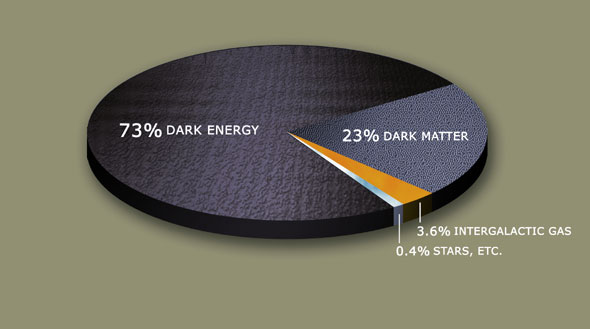According to an announcement today from Nasa posted on Space.Com
A massive particle detector mounted on the International Space Station may have detected elusive dark matter at last, scientists announced today (April 3).
The detector, the Alpha Magnetic Spectrometer (AMS), measures cosmic-ray particles in space. After detecting billions of these particles over a year and a half, the experiment recorded a signal that may be the result of dark matter, the hidden substance that makes up more than 80 percent of all matter in the universe.
AMS found about 400,000 positrons, the antimatter partner particles of electrons. The energies of these positrons suggest they might have been created when particles of dark matter collided and destroyed each other.
So what?
In astronomy and cosmology, dark matter is a type of matter hypothesized to account for a large part of the total mass in the universe. Dark matter cannot be seen directly with telescopes; evidently it neither emits nor absorbs light or other electromagnetic radiation at any significant level. Instead, its existence and properties are inferred from its gravitational effects on visible matter, radiation, and the large-scale structure of the universe. Dark matter is estimated to constitute 84.5% of the matter in the universe and 26.8% of the total energy density (with almost all the rest being dark energy).
To put it another way, if the theories about the “Big Bang” are to work then there must have been a certain amount of matter/energy present to cause what we see as the result. Physicists have calculated that amount within a margin of error and a whole bunch of that matter/energy is missing. We cannot see it or have not detected it in the Universe today. So where is it? Well we think it is all around us. I am sure you have all seen the cool animations of planets orbiting stars as if they were pool balls rolling around a funnel. Yes? Well that funnel also causes light waves to alter their course and we can see that when observing stars pass behind heavy objects like other planets in our solar system. We have also calculated the amount of matter (within a certain range) that constitutes other nearby galaxies, and so can calculate the gravity and thus the distortion we should see of objects behind them. When we observe that distortion it is significantly greater than the projections and well outside the margin of error in our calculations. The leading theory for this is Dark Matter contributing to the total gravity of those galaxies.
The proportions are something like this

Dark Matter should not be confused with Anti Matter. Anti Matter is really the same as the matter we are familiar with and interact with every day except the charge of the particles that make up anti-matter are the reverse of what we call matter. It is believed that nearly equal amounts of matter and antimatter were present at the instant of the creation of the Universe, but that there was just a little bit more matter so the balancing amounts of matter and anti-matter destroyed each other and what was left behind is what we see today.
So as we close in on the Higgs Boson which gives atomic particles mass and fills in the last piece of The Standard Model, which is the mathematical equation that describes the early moments of the “Big Bang” and all the various particles and energies that must have been present for events to take place the way we believe they did, we are also hopefully closing in on the Dark Matter which tells us all the stuff that is missing is really here. Probably made up of socks that go missing in the dyer, and the last inch of every pencil ever made, everywhere.
And don’t forget to visit Lindsay, say Hi and Like us on our FaceBook Page.
3 comments




